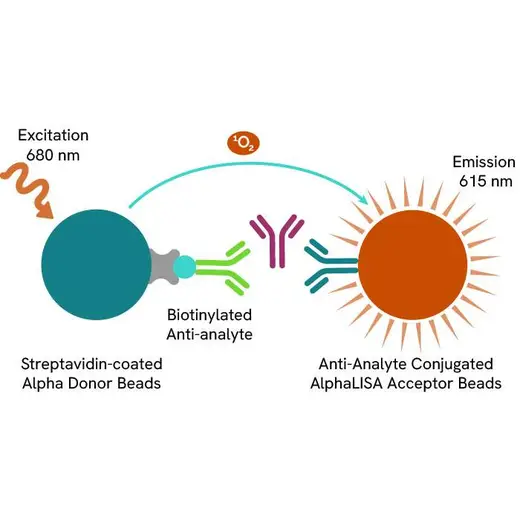
AlphaLISA Mouse MMP9 Detection Kit, 500 Assay Points


 View All
View All
AlphaLISA Mouse MMP9 Detection Kit, 500 Assay Points














The AlphaLISA™ Mouse Matrix Metalloproteinase-9 (MMP9) Detection Kit is designed for detection and quantitation of murine MMP9 in serum, buffered solution or cell culture medium in a homogeneous (no-wash steps, no separation steps) assay. The kit was designed to detect both MMP9 and pro-MMP9.
For research use only. Not for use in diagnostic procedures. All products to be used in accordance with applicable laws and regulations including without limitation, consumption and disposal requirements under European REACH regulations (EC 1907/2006).
| Feature | Specification |
|---|---|
| Application | Protein Quantification |
| Dynamic Range | 19.9 - 300,000 pg/mL |
| Limit of Detection | 19.9 pg/mL |
| Sample Volume | 5 µL |
The AlphaLISA™ Mouse Matrix Metalloproteinase-9 (MMP9) Detection Kit is designed for detection and quantitation of murine MMP9 in serum, buffered solution or cell culture medium in a homogeneous (no-wash steps, no separation steps) assay. The kit was designed to detect both MMP9 and pro-MMP9.
For research use only. Not for use in diagnostic procedures. All products to be used in accordance with applicable laws and regulations including without limitation, consumption and disposal requirements under European REACH regulations (EC 1907/2006).







AlphaLISA Mouse MMP9 Detection Kit, 500 Assay Points







AlphaLISA Mouse MMP9 Detection Kit, 500 Assay Points







Product information
Overview
Formats:
- Our 500 assay point kit allows you to run 500 wells in 96-well or 384-well format, using a 50 µL reaction volume (5 µL of sample).
- Our 5,000 assay point kit allows you to run 5,000 wells in 96-well or 384-well format, using a 50 µL reaction volume (5 µL of sample).
Features:
- No-wash steps, no separation steps
- ELISA alternative technology
- Sensitive detection
- Broad sample compatibility
- Small sample volume
- Results in less than 3 hours
- Half the time of an ELISA assay
Mouse Matrix Metalloproteinase-9 (MMP9) or gelatinase B is a precursor maturing into a 69 kDa, zinc- and calciumdependent, endopeptidase secreted by normal alveolar macrophages and granulocytes. MMP9 is secreted as a proenzyme (pro-MMP9) and is activated by proteolytic cleavage by serine proteases including other MMPs. In human, MMP9 is believed to act synergistically with MMP1 interstitial collagenase in the degradation of fibrillar collagens. MMP9 might contribute to the pathogenesis of joint destruction. MMP9 could also play a role in bone osteoclastic resorption and cancer metastasis. MMP9 constitutes a useful biomarker of disease status in arthritis and certain cancers.
AlphaLISA technology allows the detection of molecules of interest in a no-wash, highly sensitive, quantitative assay. In an AlphaLISA assay, a biotinylated anti-analyte antibody binds to the Streptavidin-coated Donor beads while another anti-analyte antibody is conjugated to AlphaLISA Acceptor beads. In the presence of the analyte, the beads come into close proximity. The excitation of the Donor beads causes the release of singlet oxygen molecules that triggers a cascade of energy transfer in the Acceptor beads, resulting in a sharp peak of light emission at 615 nm.
Specifications
| Application |
Protein Quantification
|
|---|---|
| Automation Compatible |
Yes
|
| Brand |
AlphaLISA
|
| Detection Modality |
Alpha
|
| Dynamic Range |
19.9 - 300,000 pg/mL
|
| Limit of Detection |
19.9 pg/mL
|
| Product Group |
Kit
|
| Sample Volume |
5 µL
|
| Shipping Conditions |
Shipped in Blue Ice
|
| Target |
MMP9
|
| Target Class |
Biomarkers
|
| Target Species |
Mouse
|
| Technology |
Alpha
|
| Therapeutic Area |
Oncology
|
| Unit Size |
500 Assay Points
|
Image gallery






AlphaLISA Mouse MMP9 Detection Kit, 500 Assay Points






AlphaLISA Mouse MMP9 Detection Kit, 500 Assay Points






Video gallery

AlphaLISA Mouse MMP9 Detection Kit, 500 Assay Points

AlphaLISA Mouse MMP9 Detection Kit, 500 Assay Points

Citations
Resources
Are you looking for resources, click on the resource type to explore further.
In a recent study, a team of international researchers used genomic data from modern human populations to better understand how...


How can we help you?
We are here to answer your questions.






























